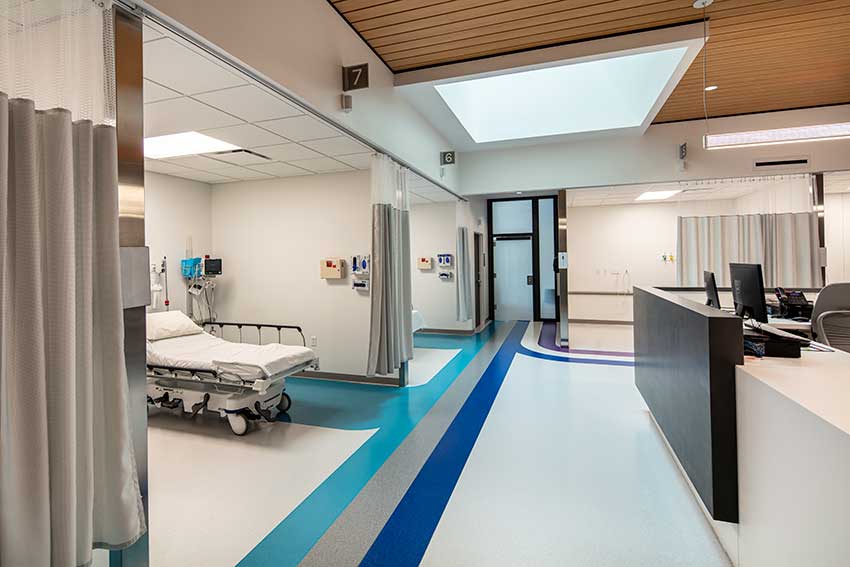Acoustic design requires an approach where absorption, isolation, and background sound performance work together without sacrificing aesthetic design. Three important components of acoustical performance are sound absorption, interior isolation, and mechanical (HVAC) noise control.
Unlike sound blocking, sound absorption is what happens when a material has the ability to absorb and dampen the sound. Softer materials, such as carpets, fabric panels, or perforated ceiling tiles, are most often used for this purpose. In a classroom full of kids, an open office with collaborating employees, or a medical facility where conversations need to be both private and intelligible, sound absorption is key. Sound absorption is calculated in terms of the NRC, which measures the amount of sound absorbed by ceiling panels or other materials. The higher the NRC, the higher the absorption.
Designing intentionally for a comfortable acoustic environment is important in supporting the safety, health, healing, and well-being for patients, staff, and visitors alike in any healthcare setting. An optimized acoustic environment reduces stress not only for the patient but also for doctors, nurses, and support staff. It can reduce errors and aid in good communication, which is essential in settings where accuracy is of the utmost importance.
Acoustics in healthcare settings also need to support speech privacy. Patients and their healthcare providers must be able to talk candidly about the patient’s condition, while adhering to confidentiality rules and HIPAA standards. A patient who feels their conversation may be overheard might end up withholding certain vital information or be reluctant to voice all their concerns. Maintaining speech privacy in healthcare settings encourages honest communication among patients, providers, and family members.
High-performance acoustical ceilings can improve patient and resident comfort and safety, while helping maintain caregiver and employee morale, focus, and productivity.
Several healthcare design guidelines emphasize the importance of acoustics in the design of healthcare environments. Published standards include Sound and Vibration Design Guidelines for Hospital and Healthcare Settings, HIPAA, Facilities Guidelines Institute FGI/ASHE Guidelines for Design and Construction for Health Care Facilities, LEED for Healthcare, and the Green Guide for Health Care.
Although we are focusing on health care environments, it is important to note that IEQ components are also essential to design in schools and offices, where speech intelligibility and productivity affect occupant health, safety, and well-being. In a big-picture view, it is worth thinking about how the indoor environmental quality of spaces in which we live, work, and play can set the stage for our long-term health. IEQ in healthcare spaces is important, but a holistic view of architecture can consider these other environments as spaces where preventative healthcare begins.
Building Resilience And Safety
The Urban Land Institute describes resilience for buildings as “the ability to prepare and plan for, absorb, recover from and more successfully adapt to adverse events.” Resilient buildings are created with resilient products that prove their ability to take on stressors and still absorb and retain their original state—just like how elastic returns back to form after being stretched.
Stone wool acoustical ceilings are durable, which is a quality that supports building resilience. Some of its durable aspects—such as having a resistance to moisture and mold—also support IEQ goals, including indoor air quality. Overall, a durable material can result in a longer life for the building, which can reduce costs over time and can be environmentally beneficial.
Mold and mildew will degrade the quality and performance of the ceiling system over time and affect the overall health of the building. They also create IAQ health concern for occupants and can be especially detrimental in health care spaces, particularly for people with asthma or other respiratory conditions.
Since it is made from stone, the stone wool used in ceiling tiles is hydrophobic. It does not absorb moisture and will not support mold and mildew growth. Stone wool is also unaffected by changes in temperature and humidity. The acoustical tile systems facilitate air flow and resist humidity. One benefit of this resistance to humidity is that opening windows and allowing fresh air to enter the building does not affect the ceiling performance.
As we’ve discussed, these healthy environments are important in all indoor settings, but vital to spaces where occupants spend long durations, such as schools, offices, and healthcare facilities. In these spaces, air flow and moisture balance contribute to better learning and health and higher productivity and satisfaction.
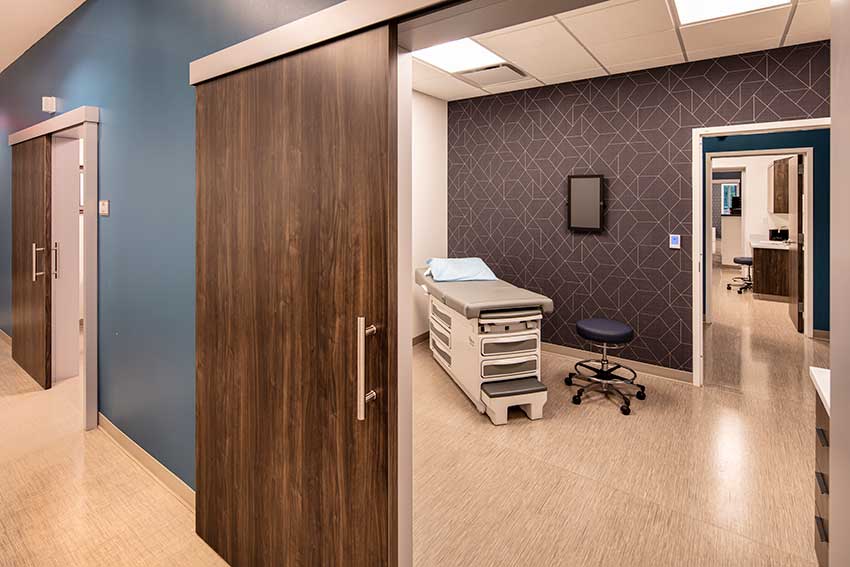
Photo courtesy of Rockfon
Stone wool ceiling systems have been certified as UL Environment GREENGUARD Gold for low volatile organic compounds (VOCs), which makes them a healthy choice for healthcare settings where more vulnerable populations reside.
Stone wool ceiling tiles meet ASTM D3273 mold testing, which is the standard test method for resistance to the growth of mold on the surface of interior coatings in an environmental chamber. In this qualitative test, the test surface is examined via microscope before and after the 28-day incubation period. Test samples are suspended in the environmental chamber with the organism species in soil at the bottom of the chamber. Results are measured on a scale of 0 to 10, and the organism species tested are Aureobasidium pullulans, Aspergillus brasiliensis (historically known as Aspergillus niger), and Penicillium citrinum.
Stone wool acoustic tiles also meet ASTM C1338 mold testing, which is the standard test method for determining fungi growth resistance of insulation materials and facings. This is a qualitative test with the same examination process and incubation period. In this test, the organism species is applied directly to the test samples. Organism species tested are Aspergillus brasiliensis, Penicillium funiculosum, Chaetomium globosum, Aspergillus flavus, and Aspergillus versicolor.
Although a European based test NF S 90-351 for Clean Rooms and Related Controlled Environments, it is interesting to note that when tested stone wool tiles specifically designed for medical environments achieve a microbiological class M1 fulfilling the requirements of NF S 90-351 in the very high-risk Zone 4.
Tested with MRSA Candida albicans and Aspergillus brasiliensis, the bactericidal and fungicidal effect of dry steam cleaning stone wool tiles meets the requirements of NF EN 14561 and NF EN 14562, meaning the disinfection is very effective.
Stone wool ceiling tiles and panels have earned UL Environment GREENGUARD Gold Certification for low volatile organic compound (VOC) emissions. This certification process takes into consideration safety factors that may impact those with vulnerable immune systems, including children and the elderly. The stringent UL GREENGUARD Gold certification is recognized by numerous green building and wellness programs, including the Collaborative for High Performance Schools (CHPS), the WELL Building Standard, and LEED.
Stone wool provides several aspects of fire protection that contribute to building resilience as well as occupant safety. High-profile fire incidents have led to increased scrutiny of building safety. More than 3.7 million fires occur in cities worldwide every year, and more than 43,000 lives are lost as a result. This, combined with the fact that fires today develop more than six times faster than in the 1950s, means there are good reasons for looking at improving fire safety requirements. Non-combustible materials, such as stone wool, play a crucial role in contributing to the fire-resistance of buildings, helping limit the spread of fire and smoke and assist in ensuring a safer environment for all residents. Stone wool ceiling tiles achieve a Class A fire rating when tested to ASTM E-84.
Indoor environmental quality (IEQ) has become a top priority in a time when awareness of health, safety and well-being is higher than ever. Ceiling systems comprise an important element in a broad range of solutions that consider IEQ and sustainability goals. In commercial buildings dedicated to healthcare, the need for flexibility and customized technology has created some challenges and led to opportunities for innovation that are holistic in approach and cutting edge in design.
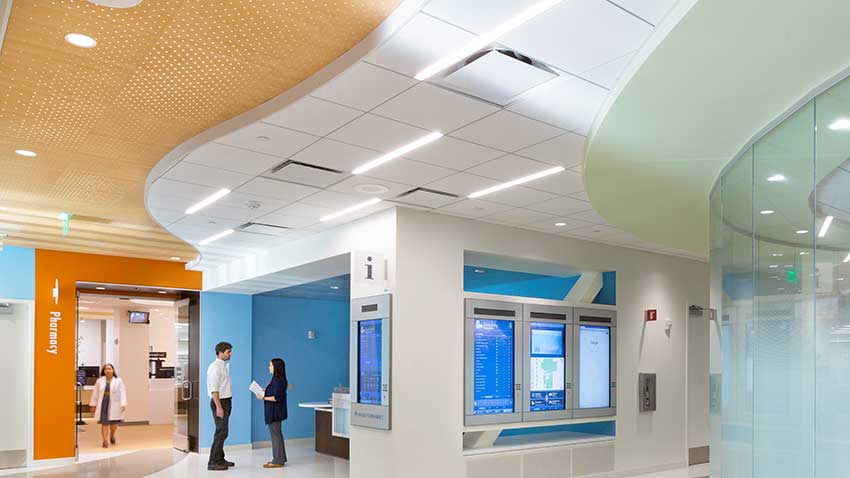
Photo courtesy of Rockfon
Inside Kaiser Permanente's new Mission Bay Medical Offices in San Francisco, stone wool ceiling systems provide quality integrated lighting and reflectance—an indoor environmental quality component essential to mood, sleep cycles, and general well-being.
IEQ refers to the quality of a building's interior environment in relation to the health and wellbeing of those who occupy it. Components of IEQ include IAQ, lighting and daylighting, aesthetics, and acoustics, all of which are vital elements for architects to consider. When IEQ is poor, occupants can suffer long-term and short-term physical and mental effects. According to the U.S. Environmental Protection Agency (EPA), Americans spend, on average, about 90% of their time indoors. For this reason, IEQ design becomes even more crucial.
Furthermore, the people most susceptible to adverse effects of poor IEQ—the very young, older adults, and people with medical conditions—tend to spend even more time indoors. Within these indoor environments, issues such as too much noise, bad air, and poor lighting can interfere with daily activities. Lack of communication, concentration, and sleep lead to stress responses such as high blood pressure and anxiety. Noise can impact mood and well-being for all those occupying the space.
Over the years, architects have taken a more holistic view of the built environment. The pandemic—in its various phases—has magnified the need for IEQ design. The emphasis on IEQ is now a gold standard for those designing buildings in healthcare. IEQ components not only matter in practical ways for health and safety, but they have also become guiding forces for exciting innovations in architectural design.
Good IEQ can enhance the lives of building occupants, increase the resale value of the building, and reduce liability for building owners. Often, a material or product may impact or support several elements of IEQ at once—and ceiling systems are a good example of that.
Few specifications could be as important as those for hospitals and other healthcare facilities. The ceiling system plays an important part in the overall healthiness of the building, as well as the health of the patients and staff. Attention should be given to ceiling systems with excellent acoustic performance to cut down on noise that can make staff irritable and inhibit patient healing. The right ceiling system can save energy on lighting and cooling. It can help prevent mold and mildew growth and can be cleaned and wiped down. It can be made of recycled and recyclable materials. And a full palette of colors can help create a warm and inviting setting appealing to patients, staff, and visitors alike.
One ceiling material that is now being specified and used in healthcare settings is stone wool.
Manufactured stone wool is composed of basalt rock, recycled material from other industries, and held together with a binder. Stone wool ceiling tiles are composed of this stone wool, plus a layer of mineral fleece, and finished with a water-based paint and sometimes a lacquer. The stone wool fibers of the tiles are intertwined in a texture that is similar to cotton candy. The non-directional fiber orientation of stone wool and the open surface make stone wool ceiling tiles and panels highly sound absorptive.
Stone wool acoustic ceiling panels are UL/ULC certified for NRC and AC. They also have other key performances that help deliver on indoor air quality: Certified as UL Greenguard GOLD for low VOC emissions, these panels have also demonstrated resistance to mold and mildew growth when tested to ASTM D3272, are easily cleanable and humidity resistant. In addition, they are rated Class A fire performance and have high light reflectance. Most of these properties contribute to IEQ goals and support the health, safety, and well-being of occupants.
Stone wool ceiling systems can integrate well with quality lighting. Their light reflectance helps enhance natural light. Natural light is vital to human functioning and plays an important role in both psychological and physiological well-being, affecting mood, sleep cycles, and productivity. A 2016 Market Report published by Dodge Data & Analytics identified access to daylight as a key feature for healthier buildings.
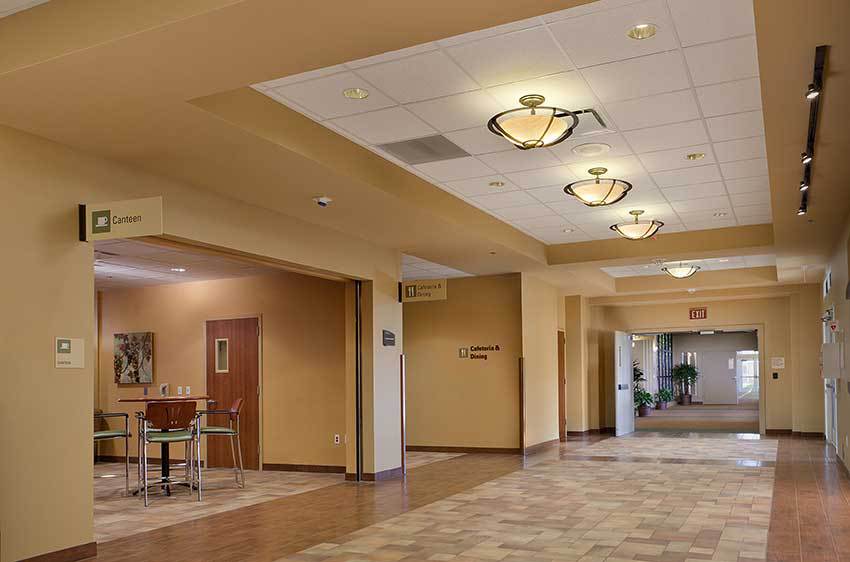
Photo courtesy of Rockfon
Ceiling systems play an important role in healthcare settings. High-performance materials such as stone wool support indoor air quality and save energy on lighting and cooling.
Aesthetics is another IEQ component that stone wool ceiling systems can achieve. Interior finishes can be used to design inspiring and beautiful interior spaces that promote health and well-being. Stone wool panels come in a variety of styles, colors, and shapes; however, the overall aesthetic is decidedly modern. Attributes can be selected to contribute to the design of a space. Biophilic design is an aesthetic type that fits well within the health care industry, has shown to aid in healing, and can be created with ceiling finishes and shapes. The concept is used within the building industry to increase occupant connectivity to the natural environment through direct nature, indirect nature, and space and place conditions.
When it comes to healthcare settings, acoustics are one of the most important design elements that affect IEQ. Optimizing acoustics in the environment requires a combination of highly absorptive ceiling panels (Noise Reduction Coefficient or NRC), robust walls with the right STC rating, as well as other elements such as floor slabs.
According to the World Health Organization, noise can seriously impact human health. Excessive or unwanted noise can cause both short- and long-term health problems. Most obviously, noise can interfere with a person’s daily activities, whether at school, work, home, or a healthcare environment. Noise can disrupt sleep and interfere with concentration; it can also induce a stress response, which comes with several potentially harmful physiological responses such as increased blood pressure. And, as most of us have experienced, unwanted noise can be irritating, thereby affecting our mood and overall well-being.
Healthcare facilities are often noisy places. For instance, many sounds are present in hospital environments, including those from beepers, alarms, machines, rolling carts, HVAC systems, and conversations, among other sources. These can be severely irritating and at times harmful to patients, depending on their current conditions (i.e., age, hearing ability, medication intake, cultural background, and pre-existing fears and anxieties). Acoustics in healthcare environments are complex and require a careful, strategic design. Specific acoustical considerations in healthcare settings include supporting patient well-being and privacy, supporting communication among staff, and meeting standards and regulations (e.g., HIPAA).
In recent years, these issues have received much attention. As evidence, acoustics are a key component of several new healthcare design guidelines; many studies identifying design strategies to improve acoustical conditions in healthcare environments have been conducted; and hospitals throughout the United States have taken initiatives to improve their acoustic environments.
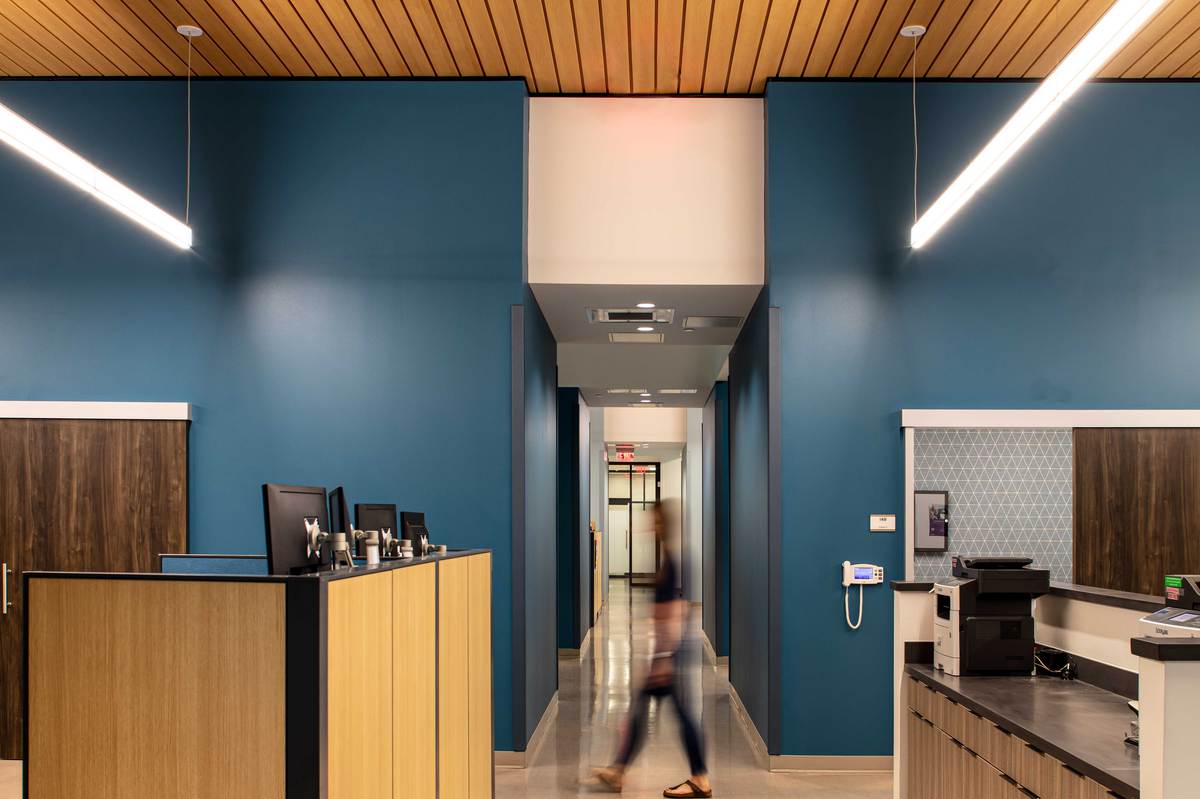
Photo courtesy of Rockfon
Architects have taken a more holistic view of health care buildings, considering the ways in which acoustics can impact the stress levels and communication abilities of both patients and staff.

Photo courtesy of Rockfon
Stone wool ceiling tiles are hydrophobic, which means they do not absorb moisture and will not support mold and mildew growth.
Acoustic design requires an approach where absorption, isolation, and background sound performance work together without sacrificing aesthetic design. Three important components of acoustical performance are sound absorption, interior isolation, and mechanical (HVAC) noise control.
Unlike sound blocking, sound absorption is what happens when a material has the ability to absorb and dampen the sound. Softer materials, such as carpets, fabric panels, or perforated ceiling tiles, are most often used for this purpose. In a classroom full of kids, an open office with collaborating employees, or a medical facility where conversations need to be both private and intelligible, sound absorption is key. Sound absorption is calculated in terms of the NRC, which measures the amount of sound absorbed by ceiling panels or other materials. The higher the NRC, the higher the absorption.
Designing intentionally for a comfortable acoustic environment is important in supporting the safety, health, healing, and well-being for patients, staff, and visitors alike in any healthcare setting. An optimized acoustic environment reduces stress not only for the patient but also for doctors, nurses, and support staff. It can reduce errors and aid in good communication, which is essential in settings where accuracy is of the utmost importance.
Acoustics in healthcare settings also need to support speech privacy. Patients and their healthcare providers must be able to talk candidly about the patient’s condition, while adhering to confidentiality rules and HIPAA standards. A patient who feels their conversation may be overheard might end up withholding certain vital information or be reluctant to voice all their concerns. Maintaining speech privacy in healthcare settings encourages honest communication among patients, providers, and family members.
High-performance acoustical ceilings can improve patient and resident comfort and safety, while helping maintain caregiver and employee morale, focus, and productivity.
Several healthcare design guidelines emphasize the importance of acoustics in the design of healthcare environments. Published standards include Sound and Vibration Design Guidelines for Hospital and Healthcare Settings, HIPAA, Facilities Guidelines Institute FGI/ASHE Guidelines for Design and Construction for Health Care Facilities, LEED for Healthcare, and the Green Guide for Health Care.
Although we are focusing on health care environments, it is important to note that IEQ components are also essential to design in schools and offices, where speech intelligibility and productivity affect occupant health, safety, and well-being. In a big-picture view, it is worth thinking about how the indoor environmental quality of spaces in which we live, work, and play can set the stage for our long-term health. IEQ in healthcare spaces is important, but a holistic view of architecture can consider these other environments as spaces where preventative healthcare begins.
Building Resilience And Safety
The Urban Land Institute describes resilience for buildings as “the ability to prepare and plan for, absorb, recover from and more successfully adapt to adverse events.” Resilient buildings are created with resilient products that prove their ability to take on stressors and still absorb and retain their original state—just like how elastic returns back to form after being stretched.
Stone wool acoustical ceilings are durable, which is a quality that supports building resilience. Some of its durable aspects—such as having a resistance to moisture and mold—also support IEQ goals, including indoor air quality. Overall, a durable material can result in a longer life for the building, which can reduce costs over time and can be environmentally beneficial.
Mold and mildew will degrade the quality and performance of the ceiling system over time and affect the overall health of the building. They also create IAQ health concern for occupants and can be especially detrimental in health care spaces, particularly for people with asthma or other respiratory conditions.
Since it is made from stone, the stone wool used in ceiling tiles is hydrophobic. It does not absorb moisture and will not support mold and mildew growth. Stone wool is also unaffected by changes in temperature and humidity. The acoustical tile systems facilitate air flow and resist humidity. One benefit of this resistance to humidity is that opening windows and allowing fresh air to enter the building does not affect the ceiling performance.
As we’ve discussed, these healthy environments are important in all indoor settings, but vital to spaces where occupants spend long durations, such as schools, offices, and healthcare facilities. In these spaces, air flow and moisture balance contribute to better learning and health and higher productivity and satisfaction.

Photo courtesy of Rockfon
Stone wool ceiling systems have been certified as UL Environment GREENGUARD Gold for low volatile organic compounds (VOCs), which makes them a healthy choice for healthcare settings where more vulnerable populations reside.
Stone wool ceiling tiles meet ASTM D3273 mold testing, which is the standard test method for resistance to the growth of mold on the surface of interior coatings in an environmental chamber. In this qualitative test, the test surface is examined via microscope before and after the 28-day incubation period. Test samples are suspended in the environmental chamber with the organism species in soil at the bottom of the chamber. Results are measured on a scale of 0 to 10, and the organism species tested are Aureobasidium pullulans, Aspergillus brasiliensis (historically known as Aspergillus niger), and Penicillium citrinum.
Stone wool acoustic tiles also meet ASTM C1338 mold testing, which is the standard test method for determining fungi growth resistance of insulation materials and facings. This is a qualitative test with the same examination process and incubation period. In this test, the organism species is applied directly to the test samples. Organism species tested are Aspergillus brasiliensis, Penicillium funiculosum, Chaetomium globosum, Aspergillus flavus, and Aspergillus versicolor.
Although a European based test NF S 90-351 for Clean Rooms and Related Controlled Environments, it is interesting to note that when tested stone wool tiles specifically designed for medical environments achieve a microbiological class M1 fulfilling the requirements of NF S 90-351 in the very high-risk Zone 4.
Tested with MRSA Candida albicans and Aspergillus brasiliensis, the bactericidal and fungicidal effect of dry steam cleaning stone wool tiles meets the requirements of NF EN 14561 and NF EN 14562, meaning the disinfection is very effective.
Stone wool ceiling tiles and panels have earned UL Environment GREENGUARD Gold Certification for low volatile organic compound (VOC) emissions. This certification process takes into consideration safety factors that may impact those with vulnerable immune systems, including children and the elderly. The stringent UL GREENGUARD Gold certification is recognized by numerous green building and wellness programs, including the Collaborative for High Performance Schools (CHPS), the WELL Building Standard, and LEED.
Stone wool provides several aspects of fire protection that contribute to building resilience as well as occupant safety. High-profile fire incidents have led to increased scrutiny of building safety. More than 3.7 million fires occur in cities worldwide every year, and more than 43,000 lives are lost as a result. This, combined with the fact that fires today develop more than six times faster than in the 1950s, means there are good reasons for looking at improving fire safety requirements. Non-combustible materials, such as stone wool, play a crucial role in contributing to the fire-resistance of buildings, helping limit the spread of fire and smoke and assist in ensuring a safer environment for all residents. Stone wool ceiling tiles achieve a Class A fire rating when tested to ASTM E-84.
Transparency And Specifying For Product Performance
In the healthcare world, there are new evidence-based designs that support reduced treatment times and increased levels of patient comfort. The Center for Health Design categorizes the use of high-performing, sound-absorptive, acoustic ceilings (NRC 0.90 or higher) as a priority design recommendation based on the strength of the evidence available and the impact on safety, quality, and cost.
Knowing how to specify for products and systems that meet these recommendations is important—and that requires independent verification. Product transparency, disclosure, and optimization documentation can help with specifying products for IEQ and resilience. Architects have a range of resources to consult for third-party testing that ensures product performance for meeting certifications. New codes and standards are now driving designers toward a higher level of IEQ characteristics, such as sound absorption and IAQ, which means resilient products are becoming the norm. These codes and standards are all highly relevant when meeting LEED, WELL, FGI, and other certifications.
When specifying for acoustic tile systems, there are a few ways to obtain verifiable product performance information. Key to transparency and product performance assurance are independent, third-party labels, evaluations, and program certifications such as UL GREENGUARD Gold and Declare and product reports such as Environmental Product Declarations and Health Product Declarations.
An Environmental Product Declaration (EPD) report summarizes the life-cycle impact of a product from “cradle to grave” based on a product’s life-cycle assessment (LCA). An EPD report includes information about a product’s global warming potential, its potential toxicity, and manufacturer’s sustainability initiatives, among other things. EPDs do not rank products. Instead, an EPD is a transparency tool that helps specifiers make choices based on sustainable qualities and environmental impacts. Products with EPDs can contribute to LEED and WELL credits.
A Health Product Declaration (HPD) is similar to an EPD but is focused on the health impacts of the product. HPDs are shared by manufacturers to disclose a product’s ingredients and any health hazards associated with the ingredients. HPDs may be created by product manufacturers, by the manufacturer’s agent, or by a third party. As with EPDs, an HPD is a transparency document that allows a specifier or building owner to compare the health impacts of products using a standardized format. Products with HPDs can also contribute to both LEED and WELL credits. With LEED Third-party verified HPDs contribute an additional ½ credit versus self verified.

Photo courtesy of Rockfon
Specifying for ceiling systems for health design includes examining product reports through third-party reports, such as a Health Product Declaration (HPD).

Photo courtesy of Rockfon
It is important to understand the specification process for ceiling systems in healthcare settings and use the planning, design, and construction guidelines set by the Facility Guidelines Institute.
These are strict requirements that help ensure products are acceptable for use in environments like healthcare facilities. The Facility Guidelines Institute (FGI) serves as an authority on health and residential care facility planning, design, and construction in the U.S. and is often used to inform guidelines abroad. The guidelines are consensus- and researched-based and are used by stakeholders across the industry including regulators, designers, and facility owners, in order to protect public health, safety and well-being.
Another verification source is Declare. Manufacturers voluntarily disclose product information on easy-to-read Declare labels. These labels report all product ingredients and use a simple color code system to flag chemicals of concern. Further information is provided on the product’s final assembly locations, life expectancy, end-of-life options, and overall compliance with relevant requirements of the Living Building Challenge (LBC).
All active Declare labels are accessible on a free and searchable database. The database is used by leading designers, large real estate owners, and conscientious homeowners to specify products they know they can trust and that meet the requirements of leading green building standards, including the Core Green Building, LBC, LEED, and WELL certifications. Declare indicates 100% disclosure and presence of a red list ingredient not covered by an exemption. Declare LBC Red List Free indicates 100% disclosure and that the product does not contain any chemical on ILFI’s red list. Declare LBC Red List Approved indicates greater than 99% disclosure and the use of an exemption.
When products are selected for IEQ features, they can often lead to building credits and certifications. For instance, LEED v4.1 offers acoustic credits in three categories we discussed previously: maximum background noise produced by HVAC systems, minimum isolation from adjacent spaces, and an adequate amount and type of sound-absorbing finishes. Walls and ceilings are the critical building components in determining whether these credits have been achieved.
The WELL v2 standard has an entire concept dedicated to acoustics, called “Sound.” There are eight features within the category, providing options for project teams to explore noise control and intentional acoustic design. The features are sound mapping, maximum noise levels, sound barriers, reverberation time, sound-reducing surfaces, minimum background sound, impact noise management, and enhanced audio devices.
CONCLUSION
By their nature, healthcare centers and hospitals host vulnerable occupants who require a healing environment. Acoustical ceiling tiles in healthcare should support important indoor environmental quality components such as acoustics, light, aesthetics, and indoor air quality. High-performance ceiling systems that are durable will hold up to infection control and cleaning measures, while also enhancing natural light and resisting moisture and mold. In this setting, products that support Indoor Air Quality can lessen the load on patients already dealing with illness and provide staff with a healthy environment as well. Extremely important to healthcare facilities are speech privacy and intelligibility, which requires ceiling tiles and systems that absorb sound so that health providers can communicate vital information and patients can sleep and recover in peaceful spaces.
The pandemic provided a spark in innovation for design. Medical centers are expected to redesign and, in future builds, imagine a whole new way of incorporating infectious disease rooms with other areas of care, in addition to lobbies, conference centers, and offices—all of which can quickly adapt to patient care if there is a crisis. These innovations continue to evolve to meet health, safety, and wellness needs by understanding and specifying for the most durable and lasting cutting-edge technologies. Ceiling systems play a major role in this evolution.
Erika Fredrickson, is a writer/editor focusing on technology, environment, and history. She frequently contributes to continuing education courses and publications through Confluence Communications.


